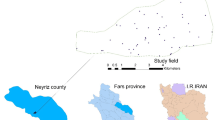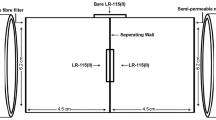Abstract
Radon and its progeny have been recognized as one of the major contributors to the natural radiation and health hazards in the human dwellings. Even lung cancer is expected if it is present in enhanced levels beyond maximum permissible limit. This paper reports the measurements of indoor radon and its progeny in the urban dwellings of the Etah district of Uttar Pradesh province in Northern India using the cellulose nitrate (LR-115 type-II) plastic track detectors. It is found that the values of radon concentration vary from 3.52 to 248.64 Bq m−3 with a standard deviation of 69.19. The values of radon progeny concentration vary from 0.38 to 26.88 mWL with a standard deviation of 7.48. The effective dose has been calculated and found to vary from 0.05 to 3.76 mSv year−1 with a standard deviation of 1.05. The lifetime fatality risk is found to vary from 0.04 × 10−4 to 2.90 × 10−4. The results have been compared with the results reported in the rural areas of the same district.
Similar content being viewed by others
References
Al-Sheriedeh SA, Bataina BA, Ershaidat NM (2006) Seasonal variations and depth dependence of soil radon concentration levels in different geological formations in Deir Abu-Said District, Irbid, Jordan. Radiat Meas 41(6):703–707
Alter HW, Fleischer RL (1981) Passive integrating radon monitor for environmental monitoring. Health Phys 40:693–702
BEIR VI (1999) Report of the committee on the biological effects of ionizing radiation. The health effects of exposure to indoor radon. National Research Council, National Academy of Science, Washington, DC
Cherouati DE, Djeffal S, Durrani SA (1988) Calibration factor for LR-115 detectors used for the measurement of alpha activity from radon. Nucl Tracks Radiat Meas 15(1–4):583–586
Durrani SA, Amin YM, Alves JM (1984) Studies of radiation damage in crystals using nuclear-track and thermoluminescence methods. Nucl Tracks Radiat Meas 8(1–4):79–84
Fleischer RL, Morgo-Campero A (1978) Mapping and integrated radon emanation for detection of long distance migration of gases within the earth; techniques and principles. J Geophys Res 83:3539–3549
ICRP-65 (1993) Protection against Radon-222 at home and at work. Ann ICRP (Pergamon Press, Oxford) 23(2):1–48
Jönsson G (1981) The angular sensitivity of Kodak LR-film to alpha particles. Nucl Instrum Methods 190:407–414
Khan MS, Naqvi AH, Azam A (2008) Study of indoor radon and its progeny levels in rural areas of North India using LR-115 plastic track detectors. Radiat Meas 43:S385–S388
Lubin JH, Boice JD Jr (1997) Lung cancer risk from residential radon: meta-analysis of eight epidemiologic studies. J Natl Cancer Inst 89:49–57
Ramola RC, Choubey VM, Negi MS, Prasad Y, Prasad G (2008) Radon occurrence in soil–gas and groundwater around an active landslide. Radiat Meas 43:98–101
Singh S, Malhotra R, Kumar J, Singh L (2001) Indoor radon measurements in dwellings of Kulu area, Himachal Pradesh, using solid state nuclear track detectors. Radiat Meas 34:505–508
Umar R (1990) Aquifer system and groundwater resource potential of Ganga Kali sub basin in part of Aligarh, Etah Districts, UP. PhD Thesis. Aligarh Muslim University, Aligarh, India
Umar R, Ahmad MS (2000) Ground water quality in parts of Central Ganga Basin, India. Environ Geol 39(6):673–678
UNSCEAR (1988) Sources, effects and risks of ionizing radiation. United Nations Scientific Committee on the effects of atomic radiation. Report to the general assembly. United Nations Publication, New York
UNSCEAR (2000) Sources and effects of ionizing radiation. United Nations Scientific Committee on the effects of atomic radiation. Report to the General Assembly. United Nations Publication, New York
Acknowledgments
The authors are thankful to Dr. R.G. Sonkawade, IUAC New Delhi, India, for providing the spark counter facility for analysis of radon and its progeny, and fruitful discussion. Authors are also thankful to the residents of the study area for their cooperation during the field work.
Author information
Authors and Affiliations
Corresponding author
Rights and permissions
About this article
Cite this article
Shakir Khan, M., Zubair, M., Verma, D. et al. The study of indoor radon in the urban dwellings using plastic track detectors. Environ Earth Sci 63, 279–282 (2011). https://doi.org/10.1007/s12665-010-0701-5
Received:
Accepted:
Published:
Issue Date:
DOI: https://doi.org/10.1007/s12665-010-0701-5




